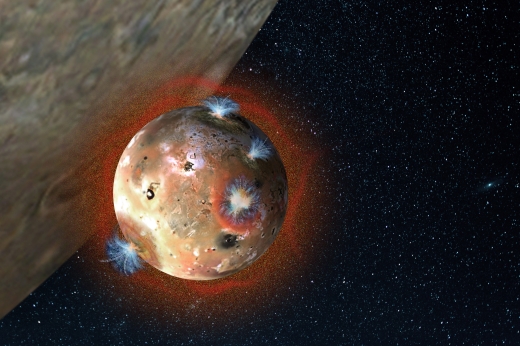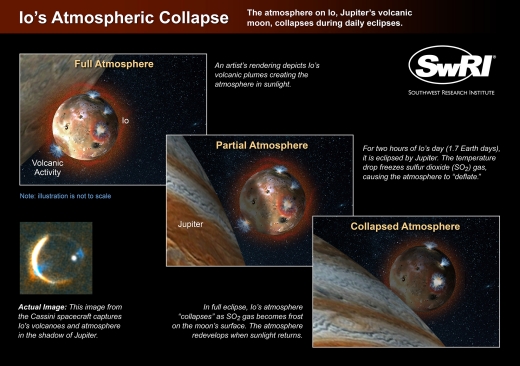I suspect most scientists would like to have a moment like the one Stanton Peale, Patrick Cassen and Ray Reynolds experienced when Voyager flew past Io in 1979. How many of us get to see a major idea vindicated in such short order? It was on March 5 that Voyager 1 passed within 22,000 kilometers of Io. A scant three days before, Peale, Cassen and Reynolds had published their prediction that tidal forces should keep the moon’s interior roiling, resulting in volcanic activity. Linda Morabito, on the Voyager navigation team, analyzed Voyager imagery shortly thereafter to discover that volcanoes were indeed active on the surface.
What a triumph for the power of thorough analysis and prediction. Voyager, in fact, found nine plumes on Io, while demonstrating that its surface was dominated by sulfur and sulfur dioxide frost, with extensive lava fields extending for hundred of kilometers. The moon was also observed to have a thin atmosphere consisting primarily of sulfur dioxide.
That thin envelope is now the subject of a new paper from Constantine Tsang (SwRI) and colleagues. We learn that gas emitted from Io’s volcanoes freezes onto the surface when Jupiter moves between Io and the Sun. Sublimation re-creates the atmosphere when sunlight returns.

Image: An artist’s rendering depicts the atmosphere on Io, Jupiter’s volcanic moon, as it collapses during daily eclipses. Credit: Southwest Research Institute.
This was the first time that atmospheric collapse and re-building on Io had been observed, a tricky procedure indeed. The scientists used the Gemini North telescope in Hawaii with the Texas Echelon Cross Echelle Spectrograph (TEXES). The latter is a high resolution mid-infrared spectrometer that was able to detect the heat signature of the atmospheric collapse.
Temperatures on Io’s surface drop from -145 degrees Celsius to -170 degrees C when a full eclipse occurs, followed by atmospheric collapse as the sulfur dioxide settles onto the surface. From the paper:
These observations provide the first direct evidence that Io’s primary molecular SO2 atmosphere collapses in eclipse, with SO2 condensing on the surface as SO2 frost. Our observations also allow us to constrain the spatial distribution of Io’s atmosphere. The fact that these observations show SO2 band depths decreasing until they almost disappear implies the atmosphere, at least on the hemisphere centered around 340° that is observed during eclipses, is global and not centered over volcanic hotspots; i.e., localized SO2 over active volcanoes is a minor component of the atmosphere on this hemisphere.
What we see is a moon whose tenuous atmosphere is in a continual cycle of collapse and restoration. It’s known that the volcanoes of Io are the source of the sulfur dioxide in the atmosphere, but we now have a demonstration of the power of sunlight to control atmospheric pressure as it changes the temperature of surface ice, resulting in the sublimation that rebuilds the atmosphere after an eclipse. This is a daily phenomenon on Io, where the day is 1.7 Earth days long, and an eclipse by Jupiter occurs for two hours out of every day.
Image (click to enlarge): Atmospheric collapse on Io in a series of images. Credit: Southwest Research Institute.
These findings are still a work in progress, for recent observations by the Hubble instrument have contradicted them by suggesting that Io’s atmosphere does not respond quickly to sunlight as the moon comes out of eclipse. There may, in other words, be longitudinal variations here. Where the atmosphere is thickest, emission from the volcanoes may mask the sublimation seen in the Gemini North data. It will take further observations to resolve the matter.
The paper is Tsang et al., “The Collapse of Io’s Primary Atmosphere in Jupiter Eclipse,” published online by the Journal of Geophysical Research 2 August 2016 (full text).




There were also pre-Voyager predictions that Europa would have a global ocean of liquid water. The detailed history of that is here:
https://www.math.washington.edu/~greenber/EuropaHistory.html
A quote from a paper connected to the above site:
“The Galilean moons of Jupiter have already once proved that human beings are not the center of the Universe. The discovery that these bodies were revolving around the planet Jupiter, and not around the Earth, convinced Galileo of the validity of the Copernican theory. Perhaps these moons will soon show us that our Earth is also not the only abode of life in our Universe, an idea which many people strongly believe, but which still has not been proven. If we do find life on Europa, just think of what we can learn by studying its nature. Is the underlying biochemistry totally different, or are there extensive similarities? The answer would give clues to the origin of life on Earth. If complex creatures have evolved, it would be fascinating to see the paths that evolution, totally independent of that on Earth, has taken. And suppose that Callisto or Ganymede has underground seas and that life has evolved there also, again totally independently of that on Earth or Europa. What would these life forms be like? And then there are the moons of other planets..in the outer Solar System. Perhaps, within the next twenty years or so, we will find answers to some of these questions. ”
The page:
https://www.math.washington.edu/~greenber/EuropaCommentary.html
In the 1978 book titled Murmurs of Earth about the Voyager Interstellar Record, Carl Sagan noted in the chapter about what the space probes were likely to find in the outer Sol system the unusual interactions between Io and Jupiter. He surmised that perhaps salt deposits from an ancient ocean were being blown off the moon’s surface into space, creating the sodium cloud around it.
Active volcanoes on an alien moon in our own solar system were just too wild a concept then, at least for most. Of course scientists were aware of the giant volcanoes on Mars thanks to Mariner 9 in 1971-1972, but they were apparently extinct. I will never forget the day Voyager 1 sent back those first good close-up images of the Galilean moons in March of 1979 and changed what we thought we knew about our celestial neighbors – especially Io and Europa.
Now Pioneer 10 and 11 did image the Galilean moons when they first flew through the Jovian system in 1973 and 1974, respectively, but their cameras just were not good enough. And Jupiter’s intense radiation fields kept Pioneer 10 from making the few better images of Io the mission team had hoped to capture when the probe flew by that moon. The active volcanoes debut would have to wait.
http://history.nasa.gov/SP-349/p180.htm
The 1977 edition of the official NASA history of the Pioneer 10 and 11 missions had this to say about what those probes found at the Galilean moons here:
http://history.nasa.gov/SP-349/ch9.htm#180
If they only knew, or at least had better cameras.
Somehow we either need to subdue Io or get rid if it so we can use Jupiter’s magnetic field to power our outward journey.
I was very young when the Voyagers passed Jupiter, but watching the screen outputs coming into mission control on a documentary is just fab. Bit by bit the image comes in to reveal volcanic plumes on Io. Has to be one of the iconic moments in space exploration. Still much to learn from this system.
I was thinking of getting a petition together to get rid of Io but I might be 500 years too early!
Why get rid of Io when you could use its interactions with Jupiter as a power source for colonization:
ftp://space.mit.edu/pub/plasma/publications/jwb_io/jwb_io.withthumbs.pdf
https://arxiv.org/ftp/astro-ph/papers/0209/0209070.pdf
http://cosmoquest.org/forum/showthread.php?106670-Using-Io-s-Flux-tube-as-energy-source-in-Jovian-system&s=b69d768b9952779ddd3fd2f542cd47cf
Of course if the Sol system is turned into a Dyson Shell/Swarm, all this will be moot.
The problem is mainly sulphur undergoing acceleration and creating a radiation hazard. Io by itself is a great asset if the sulphur could be eliminated as a couple of coils around the poles or a conducting tether towards Jupiter would generate a colossal amount of power.
https://en.wikipedia.org/wiki/Io_%28moon%29#/media/File:Jupiter_magnetosphere_schematic.jpg
Perhaps covering the surface of the other moons with a reflective aerogel will reduce the number of ions from them. Io would need a means of getting rid of heat and preventing material leaving the surface, perhaps a reflective nanotube webbing.
Voyager 2 flew past Saturn 35 years ago on August 25, 1981:
http://www.jpl.nasa.gov/news/news.php?release=2016-217